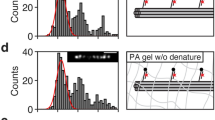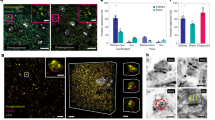Abstract
Expansion microscopy (ExM) physically magnifies biological specimens to enable nanoscale-resolution imaging using conventional microscopes. Current ExM methods permeate specimens with free-radical-chain-growth-polymerized polyacrylate hydrogels, whose network structure limits the local isotropy of expansion as well as the preservation of morphology and shape at the nanoscale. Here we report that ExM is possible using hydrogels that have a more homogeneous network structure, assembled via non-radical terminal linking of tetrahedral monomers. As with earlier forms of ExM, such ‘tetra-gel’-embedded specimens can be iteratively expanded for greater physical magnification. Iterative tetra-gel expansion of herpes simplex virus type 1 (HSV-1) virions by ~10× in linear dimension results in a median spatial error of 9.2 nm for localizing the viral envelope layer, rather than 14.3 nm from earlier versions of ExM. Moreover, tetra-gel-based expansion better preserves the virion spherical shape. Thus, tetra-gels may support ExM with reduced spatial errors and improved local isotropy, pointing the way towards single-biomolecule accuracy ExM.
This is a preview of subscription content, access via your institution
Access options
Access Nature and 54 other Nature Portfolio journals
Get Nature+, our best-value online-access subscription
$29.99 / 30 days
cancel any time
Subscribe to this journal
Receive 12 print issues and online access
$259.00 per year
only $21.58 per issue
Buy this article
- Purchase on Springer Link
- Instant access to full article PDF
Prices may be subject to local taxes which are calculated during checkout





Similar content being viewed by others
Data availability
Source data are provided with this paper. The total raw data size of the study exceeds 350 GB. The data that support this study are available from the authors upon reasonable request.
Code availability
Analysis code used in this study, including virus particle analysis48, microtubule peak-to-peak distance analysis49 and HSV-1 averaged particle image simulation50 are available at https://github.com/jayyu0528/.
References
Chen, F., Tillberg, P. W. & Boyden, E. S. Expansion microscopy. Science 347, 543–548 (2015).
Gao, R., Asano, S. M. & Boyden, E. S. Q&A: expansion microscopy. BMC Biol. 15, 50 (2017).
Wassie, A. T., Zhao, Y. & Boyden, E. S. Expansion microscopy: principles and uses in biological research. Nat. Methods 16, 33–41 (2019).
Asano, S. M. et al. Expansion microscopy: protocols for imaging proteins and RNA in cells and tissues. Curr. Protoc. Cell Biol. 80, e56 (2018).
Hafner, A. S., Donlin-Asp, P. G., Leitch, B., Herzog, E. & Schuman, E. M. Local protein synthesis is a ubiquitous feature of neuronal pre- and postsynaptic compartments. Science 364, eaau3644 (2019).
Schlichting, M. et al. Light-mediated circuit switching in the Drosophila neuronal clock network. Curr. Biol. 29, 3266–3276.e3 (2019).
Zhao, Y. et al. Nanoscale imaging of clinical specimens using pathology-optimized expansion microscopy. Nat. Biotechnol. 35, 757–764 (2017).
Tillberg, P. W. et al. Protein-retention expansion microscopy of cells and tissues labeled using standard fluorescent proteins and antibodies. Nat. Biotechnol. 34, 987–992 (2016).
Chozinski, T. J. et al. Expansion microscopy with conventional antibodies and fluorescent proteins. Nat. Methods 13, 485–488 (2016).
Chen, F. et al. Nanoscale imaging of RNA with expansion microscopy. Nat. Methods 13, 679–684 (2016).
Ku, T. et al. Multiplexed and scalable super-resolution imaging of three-dimensional protein localization in size-adjustable tissues. Nat. Biotechnol. 34, 973–981 (2016).
Gambarotto, D. et al. Imaging cellular ultrastructures using expansion microscopy (U-ExM). Nat. Methods 16, 71–74 (2019).
Gao, R. et al. Cortical column and whole-brain imaging with molecular contrast and nanoscale resolution. Science 363, eaau8302 (2019).
Chang, J.-B. et al. Iterative expansion microscopy. Nat. Methods 14, 593–599 (2017).
Truckenbrodt, S. et al. X10 expansion microscopy enables 25 nm resolution on conventional microscopes. EMBO Rep. 19, e45836 (2018).
Cohen, Y., Ramon, O., Kopelman, I. J. & Mizrahi, S. Characterization of inhomogeneous polyacrylamide hydrogels. J. Polym. Sci. B Polym. Phys. 30, 1055–1067 (1992).
Yazici, I. & Okay, O. Spatial inhomogeneity in poly(acrylic acid) hydrogels. Polymer 46, 2595–2602 (2005).
Orakdogen, N. & Okay, O. Correlation between crosslinking efficiency and spatial inhomogeneity in poly(acrylamide) hydrogels. Polym. Bull. 57, 631–641 (2006).
Di Lorenzo, F. & Seiffert, S. Nanostructural heterogeneity in polymer networks and gels. Polym. Chem. 6, 5515–5528 (2015).
Gu, Y., Zhao, J. & Johnson, J. A. A (macro)molecular-level understanding of polymer network topology. Trends Chem. 1, 318–334 (2019).
Martens, P. & Anseth, K. S. Characterization of hydrogels formed from acrylate modified poly(vinyl alcohol) macromers. Polymer 41, 7715–7722 (2000).
Lutolf, M. P. & Hubbell, J. A. Synthesis and physicochemical characterization of end-linked poly(ethylene glycol)-co-peptide hydrogels formed by Michael-type addition. Biomacromolecules 4, 713–722 (2003).
Malkoch, M. et al. Synthesis of well-defined hydrogel networks using Click chemistry. Chem. Commun. 2774–2776 (2006).
Sakai, T. et al. Design and fabrication of a high-strength hydrogel with ideally homogeneous network structure from tetrahedron-like macromonomers. Macromolecules 41, 5379–5384 (2008).
Fairbanks, B. D. et al. A versatile synthetic extracellular matrix mimic via thiol-norbornene photopolymerization. Adv. Mater. 21, 5005–5010 (2009).
Cui, J. et al. Synthetically simple, highly resilient hydrogels. Biomacromolecules 13, 584–588 (2012).
Saffer, E. M. et al. SANS study of highly resilient poly(ethylene glycol) hydrogels. Soft Matter 10, 1905–1916 (2014).
Matsunaga, T., Sakai, T., Akagi, Y., Chung, U.-i. & Shibayama, M. Structure characterization of Tetra-PEG gel by small-angle neutron scattering. Macromolecules 42, 1344–1351 (2009).
Matsunaga, T., Sakai, T., Akagi, Y., Chung, U.-i. & Shibayama, M. SANS and SLS studies on tetra-arm PEG gels in as-prepared and swollen states. Macromolecules 42, 6245–6252 (2009).
Oshima, K., Fujimoto, T., Minami, E. & Mitsukami, Y. Model polyelectrolyte gels synthesized by end-linking of tetra-arm polymers with click chemistry: synthesis and mechanical properties. Macromolecules 47, 7573–7580 (2014).
Kamata, H., Akagi, Y., Kayasuga-Kariya, Y., Chung, U.-i. & Sakai, T. “Nonswellable” hydrogel without mechanical hysteresis. Science 343, 873–875 (2014).
Tricot, M. Comparison of experimental and theoretical persistence length of some polyelectrolytes at various ionic strengths. Macromolecules 17, 1698–1704 (1984).
Kienberger, F. et al. Static and dynamical properties of single poly(ethylene glycol) molecules investigated by force spectroscopy. Single Mol. 1, 123–128 (2000).
Kuhn, W. Über die Gestalt fadenförmiger Moleküle in Lösungen. Kolloid Z. 68, 2–15 (1934).
Kuhn, W. & Kuhn, H. Die Frage nach der Aufrollung von Fadenmolekeln in strömenden Lösungen. Helv. Chim. Acta 26, 1394–1465 (1943).
Debye, P. & Hückel, E. The theory of electrolytes. I. Lowering of freezing point and related phenomena. Phys. Z. 24, 185–206 (1923).
Dommerholt, J., Rutjes, F. P. J. T. & van Delft, F. L. Strain-promoted 1,3-dipolar cycloaddition of cycloalkynes and organic azides. Top. Curr. Chem. 374, 16 (2016).
Zander, Z. K., Hua, G., Wiener, C. G., Vogt, B. D. & Becker, M. L. Control of mesh size and modulus by kinetically dependent cross-linking in hydrogels. Adv. Mater. 27, 6283–6288 (2015).
Hughes, M. P., Morgan, H. & Rixon, F. J. Dielectrophoretic manipulation and characterization of herpes simplex virus-1 capsids. Eur. Biophys. J. 30, 268–272 (2001).
Liu, F. & Zhou, Z. H. in Human Herpesviruses: Biology, Therapy, and Immunoprophylaxis (eds Arvin, A. et al.) 27–43 (Cambridge Univ. Press, 2007).
Brown, J. C. & Newcomb, W. W. Herpesvirus capsid assembly: Insights from structural analysis. Curr. Opin. Virol. 1, 142–149 (2011).
Grünewald, K. et al. Three-dimensional structure of herpes simplex virus from cryo-electron tomography. Science 302, 1396–1398 (2003).
Maurer, U. E., Sodeik, B. & Grünewald, K. Native 3D intermediates of membrane fusion in herpes simplex virus 1 entry. Proc. Natl Acad. Sci. USA 105, 10559–10564 (2008).
Laine, R. F. et al. Structural analysis of herpes simplex virus by optical super-resolution imaging. Nat. Commun. 6, 5980 (2015).
Liu, J., Wright, E. R. & Winkler, H. in Cryo-EM, Part C: Analyses, Interpretation, and Case studies Vol. 483 (ed. Jensen, G. J.) 267–290 (Academic, 2010).
Park, Y.-G. et al. Protection of tissue physicochemical properties using polyfunctional crosslinkers. Nat. Biotechnol. 37, 73–83 (2019).
Neve, R. L., Neve, K. A., Nestler, E. J. & Carlezon, W. A. Use of herpes virus amplicon vectors to study brain disorders. Biotechniques 39, 381–391 (2005).
Yu, C.-C. Virus particle analysis. Github https://github.com/jayyu0528/(2020).
Yu, C.-C. Microtubule peak-to-peak distance analysis. Github https://github.com/jayyu0528/ (2020).
Yu, C.-C. HSV-1 averaged particle image simulation. Github https://github.com/jayyu0528/ (2020).
Acknowledgements
We thank Y.-Y. Chou and T. Kirchhausen at HMS for help with VSV stock preparation and virion immobilization; C. Linghu and O. Shemesh for help with HSV-1 stock preparation; P. Valdes and C. Zhang for helpful discussion about sample staining and expansion; M. J. Kauke for helpful discussion about DNA staining; S. M. Asano for helpful discussion about image analysis; G. H. Huynh for help with mouse brain slice preparation; F. Chen for helpful discussion about monomer and polymerization chemistry design; R. Herlo at HMS for helpful discussion about virion envelope proteins. E.S.B. acknowledges L. Yang and Y. E. Tan, J. Doerr, the Open Philanthropy Project, NIH 1R01NS087950, NIH 1RM1HG008525, NIH 1R01DA045549, NIH 2R01DA029639, NIH 1R01NS102727, NIH 1R01EB024261, NIH 1R01MH110932, the HHMI-Simons Faculty Scholars Program, the HHMI Investigator program, IARPA D16PC00008, the US Army Research Laboratory and the US Army Research Office under contract/grant W911NF1510548, the US–Israel Binational Science Foundation Grant 2014509, NSF Grant 1734870 and the NIH Director’s Pioneer Award 1DP1NS087724. C.-C.Y. acknowledges the McGovern Institute for Brain Research at MIT for the Friends of the McGovern Fellowship. S.U. was supported by Biogen and NIH 5R01GM075252-13S grants awarded to T. Kirchhausen, and acknowledges support from Philomathia Foundation and Chan Zuckerberg Initiative Imaging Scientist program.
Author information
Authors and Affiliations
Contributions
R.G. and L.G. designed and synthesized the monomers and conducted initial gelation experiments. C.-C.Y. and R.G. designed and conducted iterative expansion, virion expansion and associated analysis. C.-C.Y. created the semi-automated virion analysis pipeline and the simulation model. K.D.P. helped characterization of the gel in cell culture. R.L.N. purified HSV-1 and prepared the virion stock solution. J.B.M. provided purified HIV virions. S.U. provided purified VSV virions and conducted initial virion immobilization experiments. C.-C.Y., R.G. and L.G. processed and performed quantitative analysis of all image data. R.G., C.-C.Y. and E.S.B. wrote the manuscript with input from all co-authors. E.S.B. supervised the project.
Corresponding author
Ethics declarations
Competing interests
R.G., C.-C.Y., L.G. and E.S.B. have filed for patent protection on a subset of the technologies here described. E.S.B. is a cofounder of a company that aims to commercialize ExM for medical purposes. R.G., C.-C.Y., L.G. and E.S.B. are co-inventors on multiple patents related to ExM. The authors declare no other competing interests.
Additional information
Peer review information Nature Nanotechnology thanks the anonymous reviewers for their contribution to the peer review of this work.
Publisher’s note Springer Nature remains neutral with regard to jurisdictional claims in published maps and institutional affiliations.
Supplementary information
Supplementary Information
Supplementary methods, Figs. 1–8 and Tables 1–3.
41565_2021_875_MOESM3_ESM.mp4
Supplementary Video 1 Three-dimensional (3D) rendered movie of envelope proteins of a herpes simplex virus type 1 (HSV-1) virion expanded by tetra-gel (TG)-based three-round iterative expansion. The deconvolved puncta (white), the overlay of the deconvolved puncta (white) and the fitted centroids (red), and the extracted centroids (red) are shown from left to right. Expansion factor, 38.3×. Scale bars, 100 nm (3.83 µm). The featured virion corresponds to virion b in Supplementary Fig. 8.
Source data
Source Data Fig. 2
Numerical data used to generate graphs.
Source Data Fig. 3
Numerical data used to generate graphs.
Source Data Fig. 4
Numerical data used to generate graphs.
Source Data Fig. 5
Numerical data used to generate graphs.
Rights and permissions
About this article
Cite this article
Gao, R., Yu, CC.(., Gao, L. et al. A highly homogeneous polymer composed of tetrahedron-like monomers for high-isotropy expansion microscopy. Nat. Nanotechnol. 16, 698–707 (2021). https://doi.org/10.1038/s41565-021-00875-7
Received:
Accepted:
Published:
Issue Date:
DOI: https://doi.org/10.1038/s41565-021-00875-7
This article is cited by
-
iU-ExM: nanoscopy of organelles and tissues with iterative ultrastructure expansion microscopy
Nature Communications (2023)
-
Photo-expansion microscopy enables super-resolution imaging of cells embedded in 3D hydrogels
Nature Materials (2023)
-
Atmospheric-moisture-induced polyacrylate hydrogels for hybrid passive cooling
Nature Communications (2023)
-
Percolation-induced gel–gel phase separation in a dilute polymer network
Nature Materials (2023)
-
Nanoscale fluorescence imaging of biological ultrastructure via molecular anchoring and physical expansion
Nano Convergence (2022)



